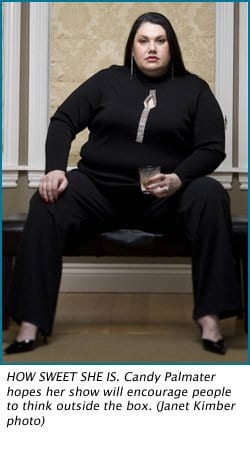Candy Palmater learnt her first life lesson on a ski-hill.
Her brother took her to the hill to give her a lesson, but began by pushing her down.
“First I’m going to teach you how to get up,” he told her, “because falling is inevitable.”
At the time, Candy thought he was talking about skiing, but later learned the lesson extended to life.
“I take big risks, but I know how to get up,” she says, in her hearty voice.
Candy is on the brink of success. She shot her first pilot of The Candy Show for APTN (Aboriginal People’s Television Network) at Halifax’s Marquee Club on Apr 8 and is waiting to see if it gets picked up.
She calls her talk show “Oprah meets David Letterman sprinkled with Candy” because it’s a mix of everything. But then again, so is she.
Candy would be unique in the television world, representing a number of minorities: she’s a Mi’kmaq and she’s gay. Candy says that the fact that she’s a gay, 300-pound aboriginal woman will “get people to go places they don’t normally go” just by watching her.
The Candy Show is something Candy has dreamt of her entire life. When she was a little girl, growing up in northern New Brunswick on her father’s Harley Davidson dealership, she would lie on her pink bed and dream of interviewing musicians.
“I was the star of the show from the start,” says Candy, the youngest of seven kids.
Her drive to make the show a reality paid off.
When working as a lawyer in Halifax, she would talk about The Candy Show whenever she met someone who worked in cable or TV. And when doing stand-up comedy, it was all towards the eventual goal of having her own show.
Candy believed if she envisioned herself doing the show, it would happen.
After quitting her job at a law firm and leaving her male partner of 12 years, Candy’s life changed. She met a woman named Denise Tompkins who became the love of her life.
Then she got a call from Dawn Harwood-Jones, asking her to come in for a screen test at the CBC. Candy went and read the lines, but during a break, told Dawn about The Candy Show.
Dawn called Candy later that night to tell her she was starting up a production company called Pink Dog Productions with her co-worker Roberta Hancock and that they were interested in hearing more about The Candy Show.
Since then, what started as a small pilot show in Chester, Nova Scotia has the potential to become a weekly show at the Marquee.
At Candy’s first taping, there were almost 300 people in the audience of Halifax’s best-known music venue. It was a diverse crowd, including a band of Mi’kmaq women and members of the gay and black communities.
The show began with Candy’s monologue: a combination of crude humour with political undertones, mocking everything from Monica Lewinsky’s blowjob to the stigma around the word “labia.”
Her first guests included blues musician Charlie A’Court, local filmmaker Juanita Peters, and Eastern Eagle, a traditional Mi’kmaq drum group.
Candy’s goal for the show is to foster talent on the East Coast. She says although her current job with the government feeds the activist in her, she needs the performance to feed her soul.
The pilot will air on APTN sometime within the next couple of months. Candy waits with crossed fingers to hear whether the network will pick it up.
When a man overhears her talking to the reporter about the show, he tells Candy he read a review in the newspaper. “Yeah?” she says proudly. “That’s me. I’m Candy from the Candy Show.”

 Why you can trust Xtra
Why you can trust Xtra


